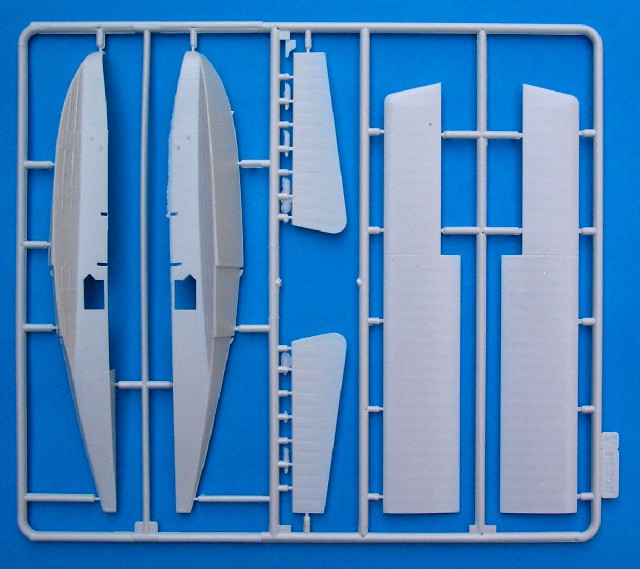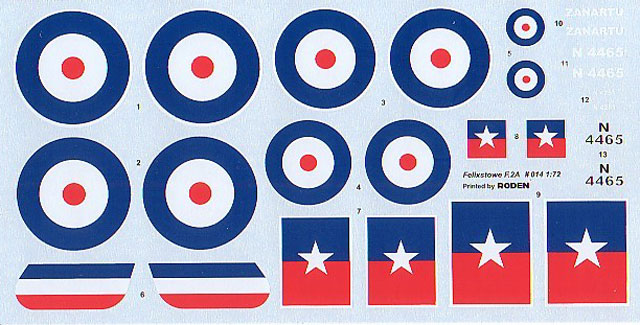|
Felixstowe F.2A “Late”

Roden 1/72
S
u m m a r y
|
| Catalogue Number: |
Felixstowe F.2A “late” Kit No.014 |
| Scale: |
1/72 |
| Contents and Media: |
229 parts in injection moulded
plastic; markings for two aircraft |
| Price: |
USD$24.97 from Squadron.com
|
| Review Type: |
FirstLook |
| Advantages: |
Superbly moulded parts, fully
detailed engines, amazing trailing edges. |
| Disadvantages: |
Unclear rigging diagram. |
| Recommendation: |
Highly Recommended |
Reviewed by Robert Baumgartner

Roden's 1/72
scale Felixstowe F.2A is available online from Squadron.com
Every now and then, a manufacturer comes out with a
product that raises the bar to new heights. With the release of this kit,
Roden have done just that.
When viewing the
contents, it is obvious that the maker has eliminated the problems that
have marred similar offerings in the past. My example showed no surface
imperfections or sink marks. The only blemish is a very slight impression
on the top of the fuselage decking caused by the ejection pin pushing a
little too hard on the sprue. This is easily fixed with a couple of scraps
from a scalpel.
There are 11 sprues, one of which is clear, that hold
229 plastic parts.

Click the
thumbnails below to view larger images:
Four aircraft are
represented on a well-printed decal sheet. Roden have chosen these schemes
wisely as they are all very different in nature.
Using the Albatros
Productions Datafile on the subject, comparison was made with the major
components. It was found that these items matched Ian Stair’s drawings
very well. As ever, take care when making direct comparisons, as the plans
are not always printed in the stated scale.
As this is the
“late” variant of the Felixstowe F.2A, the clear sprue only contains the
two individual windscreens. A future release by Roden will provide the
“early “ version with the semi enclosed cockpit canopy.
The Felixstowe’s
Rolls Royce Eagle engines are very prominent so it is fitting that Roden
have made these items a kit in themselves. Including the piping, there are
thirty parts involved and the finished products will look superb in their
exposed position between the wings.
Despite the
complexity of the assembly, no problems were encountered during this
stage.
Armament consists
of eight 0.303 in. Lewis machine guns and two 230lb bombs. A nice touch is
the supply of spare Lewis drums for the gunners’ positions.
The cockpit is made up of the usual seats, control
columns with steering wheels, floor, rudder pedals and interior rib detail
which is found inside the fuselage halves
One area that is
truly outstanding is the wings. Roden have set themselves new standards as
these items have some of the sharpest trailing edges ever to have been
done in plastic. The surface detail is commendably subtle and none of
these parts were warped in any way. This praise also extends to the
ailerons, where both balanced and unbalanced versions are provided.
The top wing is
supplied as three parts with the panel lines located as per the original.
I butt joined mine using very thin liquid cement and squeezed the parts
together to allow the melted plastic to fill any gaps. After drying and
sanding smooth, the join line was reinstated with an Olfa cutter. Others
may prefer to pin these parts for added strength but I didn’t find this
necessary.
Roden have
engineered the kit so that the completed wing cellule slides into slots
cut into the lower fuselage structure. This is quite an interesting idea
and shows that Roden are willing to try new ways of solving old problems.
Part way during the
assembly I decided to deviate from this suggestion. Only the lower wing
was placed into the grooves as this made access to cleaning up any joins
on the top deck much easier to reach. It also eased the task of painting
the fuselage.
Roden thoughtfully
provide a 17 part beaching trolley so the model can be displayed without
the aid of water.
The instruction
sheet is easy enough to follow although the rigging diagram could have
been better. Although simplified to cater for the skills of the average
modeler, the placement of these wires are still a little tough to figure
out. Not even the referred to box top helps. A three-dimensional
representation of a couple of the “hidden” areas would not have gone
amiss.
Markings
As expected with this subject matter, the colour
schemes are quite striking. There are 4 options on the decal sheet, these
consisting of both “standard” and “dazzle camouflaged” aircraft. The
latter scheme was used for easy identification in the air among their
fellow pilots. It also made “downed” aircraft more obvious to spot for
rescue craft.
(i)
Felixstowe F.2A, N4465 based at Killingholme 1918 (“basic” colour
scheme)
(ii)
Felixstowe F.2A, N4567 given to the Chilean government after the
war (“basic” scheme with Chilean insignia)
(iii)
Felixstowe F.2A, possibly based at Great Yarmouth 1918 (blue/white
“dazzle” colour scheme)
(iv)
Felixstowe F.2A (sic), N4251 possibly based at Felixstowe 1918
(red/white “dazzle” colour scheme). Sadly this striking scheme actually
belongs to an F3.
The decal sheet is still matt, which in the past has
meant they have a propensity to crack when flexed or placed over any
curved surface.

Later kit subjects have had this addressed with
decals of a different makeup. These have been shown to be a vast
improvement.
The standard shown here clearly demonstrates the
commitment that Roden have in producing quality kits of challenging
subjects.
The prominent engines receive treatment usually only
seen in larger scales and the flying surfaces have to be seen to be
believed.
Out of the box, this kit will be a showstopper and
deserves to sell well.
Highly recommended.
Thanks to
Squadron.com for the review
sample.
Review and Images Copyright © 2003 by
Robert Baumgartner
Page Created 27 August, 2003
Last updated 27 August, 2003
Back to HyperScale Main Page
Back to Reviews Page
|
Home | What's
New | Features
| Gallery |
Reviews | Reference
| Forum
| Search